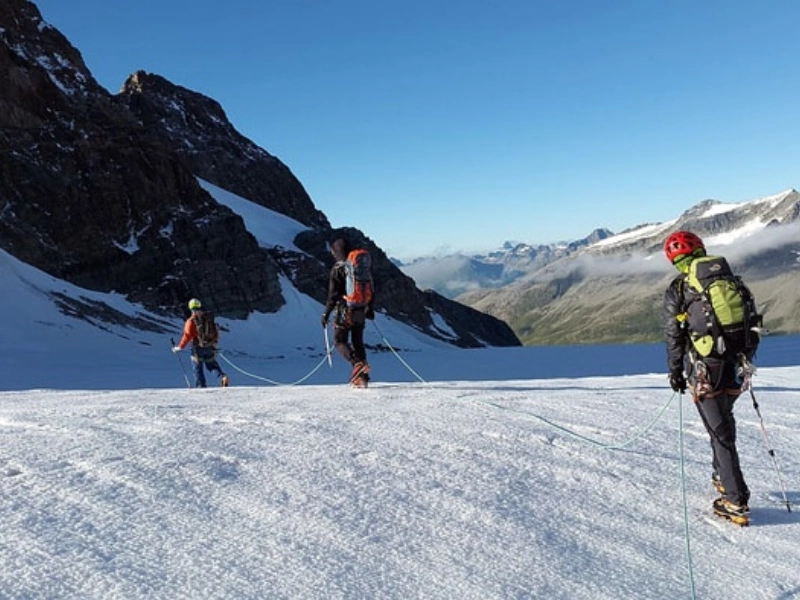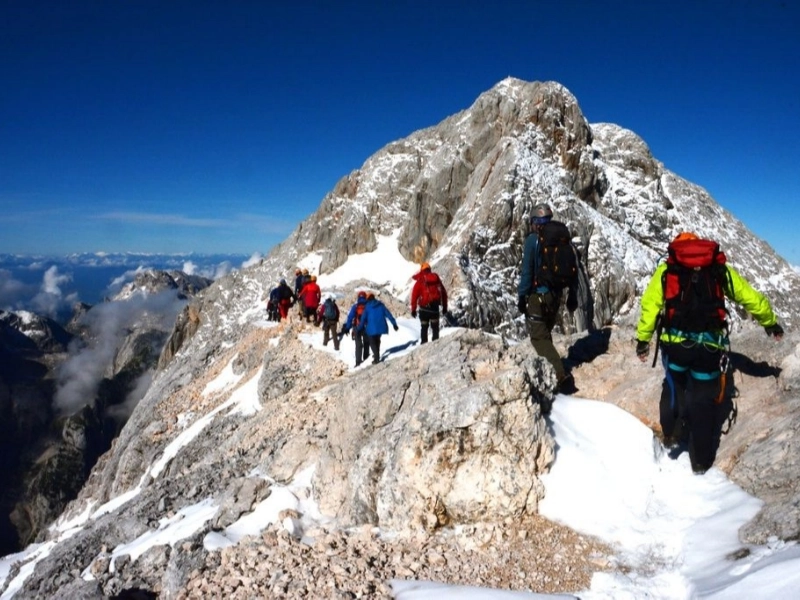Mountaineering is an endurance sport that requires slow, steady ascending over difficult terrain while carrying a heavy pack. Strong overall conditioning is necessary, as is targeted training that emulates the demands of mountain climbing. To succeed in mountaineering, you also need to learn technical skills like self-belay and plunge stepping, which is the technique of moving across snow with safe, effective footwork that keeps you from slipping.
 Choosing your own definition of mountaineering is crucial. It's easy to fall victim to the ego game and believe that just because you don't climb many alpine routes or you follow guides instead of taking independent routes, you're not a mountaineer.
Taking a course is the most effective approach to acquiring the abilities needed for mountaineering. Although there are excellent publications like the "mountain bible," Freedom of the Hills, and many individuals have friends who can teach them, attending a course places you in the mountains with knowledgeable guides who can provide you with firsthand knowledge and comments.
After completing a course, go on some travels to expand your experience. Because conditions can change quickly and proficiency with crampons and ice axes takes time, it is best to go on these treks with experienced mountaineers. Begin with mild, snowy slopes and make sure you get practice in a range of weather conditions.
Choosing your own definition of mountaineering is crucial. It's easy to fall victim to the ego game and believe that just because you don't climb many alpine routes or you follow guides instead of taking independent routes, you're not a mountaineer.
Taking a course is the most effective approach to acquiring the abilities needed for mountaineering. Although there are excellent publications like the "mountain bible," Freedom of the Hills, and many individuals have friends who can teach them, attending a course places you in the mountains with knowledgeable guides who can provide you with firsthand knowledge and comments.
After completing a course, go on some travels to expand your experience. Because conditions can change quickly and proficiency with crampons and ice axes takes time, it is best to go on these treks with experienced mountaineers. Begin with mild, snowy slopes and make sure you get practice in a range of weather conditions.
 A lot of hiking and camping in cold weather with a bulky load on your back is part of mountaineering. It also involves traversing cold and snowy terrain and engaging in rock and ice climbing. Therefore, before taking on mountaineering, you should work on honing your abilities and expertise in these areas.
Learn the fundamentals, like how to tie onto a rope, belay, and utilize a harness, by enrolling in alpine courses or joining a tramping and climbing club. Additionally, you will be able to practice fundamental mountaineering skills like using crampons—special footwear with sharp teeth that grasp onto hard ice or snow—to walk over steep ice and snow.
Prior to taking on the physical rigors of a mountaineering expedition, you will need to strengthen your cardiovascular endurance, balance, and strength. To build your basic fitness, start with a regular training regimen of running and cycling. Then, add in gym-based aerobic exercises like weightlifting and stair climbing to focus on the muscles needed for mountaineering.
A lot of hiking and camping in cold weather with a bulky load on your back is part of mountaineering. It also involves traversing cold and snowy terrain and engaging in rock and ice climbing. Therefore, before taking on mountaineering, you should work on honing your abilities and expertise in these areas.
Learn the fundamentals, like how to tie onto a rope, belay, and utilize a harness, by enrolling in alpine courses or joining a tramping and climbing club. Additionally, you will be able to practice fundamental mountaineering skills like using crampons—special footwear with sharp teeth that grasp onto hard ice or snow—to walk over steep ice and snow.
Prior to taking on the physical rigors of a mountaineering expedition, you will need to strengthen your cardiovascular endurance, balance, and strength. To build your basic fitness, start with a regular training regimen of running and cycling. Then, add in gym-based aerobic exercises like weightlifting and stair climbing to focus on the muscles needed for mountaineering.
 Enroll in an alpine or rock climbing course if you're new to climbing. This will provide you with the fundamental climbing abilities you'll need to move on to more challenging mountaineering experiences and excursions.
Enrolling in a winter climbing course is also a smart move. You will learn how to use crampons, ice axes, and how to cross glaciers from this. You will also have the opportunity to practice the vital skill of self-arrest, which is to use an ice axe or other equipment to stop yourself from falling on a snowy slope.
The majority of mountain climbers put in a lot of training in the months before their trips. This involves carrying a backpack on hikes, using weight training to strengthen the upper body, and climbing both indoors and outdoors to strengthen the arms and legs. In order to acclimate their bodies to the higher air pressure, they also spend time at altitude. It is crucial that you prepare in order to accomplish your mountaineering objectives.
Enroll in an alpine or rock climbing course if you're new to climbing. This will provide you with the fundamental climbing abilities you'll need to move on to more challenging mountaineering experiences and excursions.
Enrolling in a winter climbing course is also a smart move. You will learn how to use crampons, ice axes, and how to cross glaciers from this. You will also have the opportunity to practice the vital skill of self-arrest, which is to use an ice axe or other equipment to stop yourself from falling on a snowy slope.
The majority of mountain climbers put in a lot of training in the months before their trips. This involves carrying a backpack on hikes, using weight training to strengthen the upper body, and climbing both indoors and outdoors to strengthen the arms and legs. In order to acclimate their bodies to the higher air pressure, they also spend time at altitude. It is crucial that you prepare in order to accomplish your mountaineering objectives.
 Being at the top of a mountain has incredible rewards, but it's not easy. A reasonable level of physical fitness, technical climbing abilities, and an adventurous attitude are necessary to reach a summit. It also necessitates extensive planning in terms of itinerary, equipment, licenses, and other practical considerations.
Long days spent crawling uphill while carrying a heavy load and in frigid weather can be physically taxing. In order to limit the danger of damage and maintain optimum performance during the climb, it's critical to give yourself enough time to recover.
Whether your goal is to begin summit scrambling, ridge walking, or rock climbing, you should focus on honing your current outdoor abilities. In addition, you'll need to be familiar with first aid and mountaineering essentials on the snow. Consider completing a wilderness first aid or first responder course, as well as earning certification in glacier travel and avalanche rescue skills. The usual providers of these courses include outdoor retailers, associations, and tour companies.
Being at the top of a mountain has incredible rewards, but it's not easy. A reasonable level of physical fitness, technical climbing abilities, and an adventurous attitude are necessary to reach a summit. It also necessitates extensive planning in terms of itinerary, equipment, licenses, and other practical considerations.
Long days spent crawling uphill while carrying a heavy load and in frigid weather can be physically taxing. In order to limit the danger of damage and maintain optimum performance during the climb, it's critical to give yourself enough time to recover.
Whether your goal is to begin summit scrambling, ridge walking, or rock climbing, you should focus on honing your current outdoor abilities. In addition, you'll need to be familiar with first aid and mountaineering essentials on the snow. Consider completing a wilderness first aid or first responder course, as well as earning certification in glacier travel and avalanche rescue skills. The usual providers of these courses include outdoor retailers, associations, and tour companies.